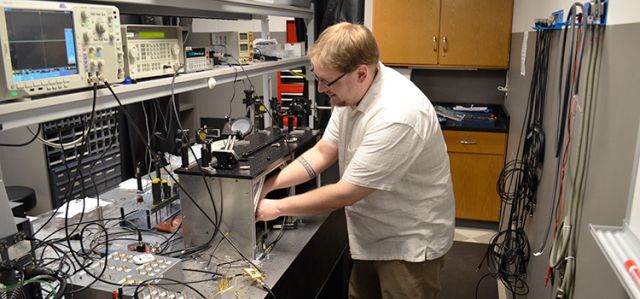Free-space Laser Communications with Adaptive Optics: Atmospheric Compensation Experiments
Document Type
Article
Publication Date
12-2004
Publication Source
Journal of Optical and Fiber Communications Reports
Abstract
Refractive index inhomogeneities of the turbulent air cause wave-front distortions of optical waves propagating through the atmosphere, leading to such effects as beam spreading, beam wander, and intensity fluctuations (scintillations). These distortions are responsible for severe signal fading in free-space optical communications systems and therefore compromise link reliability. Wave-front distortions can be mitigated, in principle, with adaptive optics, i.e., real-time wave-front control, reducing the likeliness of signal fading. However, adaptive optics technology, currently primarily used in astronomical imaging, needs to be adapted to the requirements of free-space optical communication systems and their specific challenges.
In this chapter we discuss a non-conventional adaptive optics approach that has certain advantages with respect to its incorporation into free-space optical communication terminals. The technique does not require wave-front measurements, which are difficult under the strong scintillation conditions typical for communication scenarios, but is based on the direct optimization of a performance quality metric, e.g., the communication signal strength, with a stochastic parallel gradient descent (SPGD) algorithm.
We describe an experimental adaptive optics system that consists of a beam-steering and a higher-resolution wave-front correction unit with a 132-actuator MEMS piston-type deformable mirror controlled by a VLSI system implementing the SPGD algorithm. The system optimizes the optical signal that could be coupled into a single-mode fiber after propagating along a 2.3-km near-horizontal atmospheric path. We investigate characteristics of the performance metric under different atmospheric conditions and evaluate the effect of the adaptive system. Experiments performed under strong scintillation conditions with beam-steering only as well as with higher-resolution wave-front control demonstrate the mitigation of wave-front distortions and the reduction of signal fading.
Inclusive pages
355–379
ISBN/ISSN
1867-3007
Copyright
Copyright © 2004, Springer
Publisher
Springer-Verlag
Volume
1
Issue
4
Peer Reviewed
yes
eCommons Citation
Weyrauch, Thomas and Vorontsov, Mikhail, "Free-space Laser Communications with Adaptive Optics: Atmospheric Compensation Experiments" (2004). Electro-Optics and Photonics Faculty Publications. 108.
https://ecommons.udayton.edu/eop_fac_pub/108
COinS




Comments
Permission documentation on file.